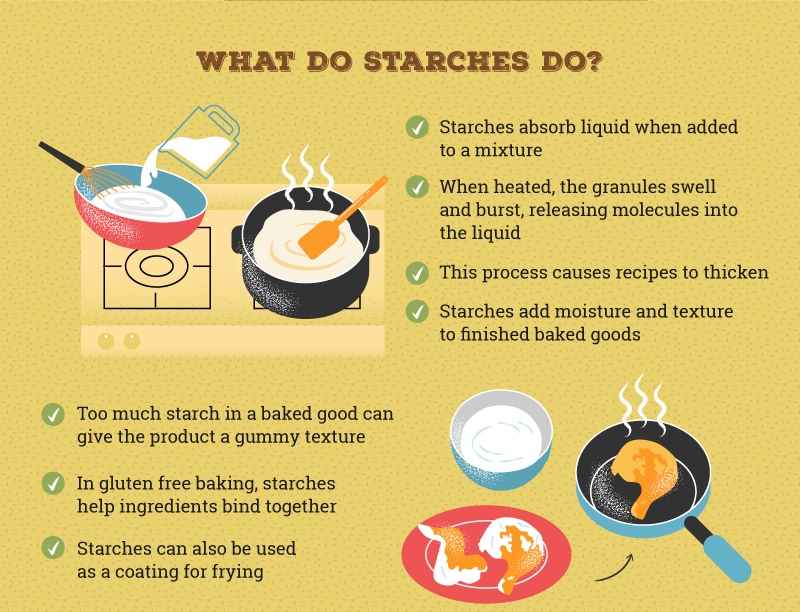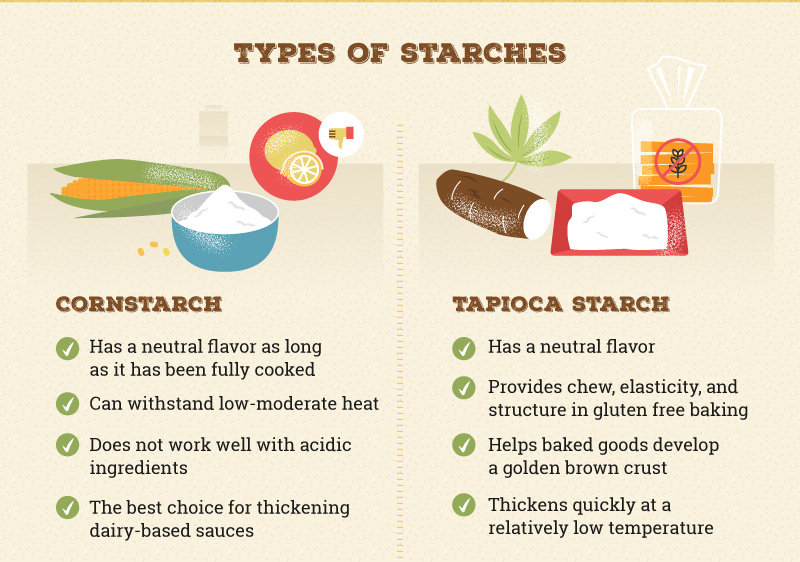

Starch are used to thicken sauces, puddings, pie fillings, etc.
Grain Starches
Wheat flour and cornstarch are the two most common forms of grain starches we use in our cooking. Because it is almost pure starch, cornstarch is a more efficient thickener than wheat flour. Both are medium-sized starch granules that gelatinize at a higher temperature than root starches. However, once that temperature is reached, thickening happens very quickly!
Grain starches also contain a relatively high percentage of fats and proteins, which can make sauces thickened with these starches look opaque and matte-like. These starches also tend to have a distinctive cereal taste once cooked.
Root and Tuber Starches
Potato starch, tapioca (made from manioc root), and arrowroot are larger-grained starches that gelatinize at relatively lower temperatures. Sauces thickened with these starches are more translucent and glossy, and they have a silkier mouthfeel. Root starches also have less forward flavors once cooked.
These root starches don’t stand up as well as grain starches to longer cooking and so they’re best used to thicken sauces toward the very end of cooking.
Grain vs Root Starch
If you need to thicken at the beginning of cooking, as for macaroni and cheese or a classic beef stew, go for a grain starch. If you need to quickly thicken a sauce just before it comes off the stove, use a root starch.
We also prefer using root starches in baking for custards, puddings, and pie fillings. We find that the flavor is more neutral and our results are more consistent
Cornstarch
Cornstarch is made from the starchy endosperm of corn and has long been used as a thickener for sauces, custards, and gravies. Bob’s Red Mill Cornstarch is made from Non-GMO corn. If your recipe calls for wheat flour as a thickener, you can use half the amount of corn starch as a substitution – it’s a pretty “strong” thickener. In gluten free baking, Corn starch can be used to add softness to gluten free baked goods like pancakes and muffins and is great when used in combination with Tapioca Starch.
- Has a neutral flavor but can leave a chalky, starchy flavor if not cooked long enough
- Should be mixed into a slurry before thickening liquid
- Can withstand low-moderate heat but will break down and lose its ability to bind in long, temperature cooking or freezing
- Does not work well with acidic ingredients
- Adds an opaque quality to sauces
Tapioca Starch
Tapioca Starch, also called Tapioca Flour, is made from the starchy tuberous root of the cassava plant. To make tapioca flour from cassava, the tubers are first peeled to remove the stem, excess soil, and skin. The peeled cassava is then thoroughly washed, chopped, and finely grated into a pulp. Water and the cassava pulp are then put into a hydrocyclone where they are spun to extract the starch and separate the fibrous pulp. The resulting starch liquid is then dried into our tapioca flour.
- Has a neutral flavor and provides chew, elasticity, and structure in gluten free baking
- Will help baked goods develop a golden brown crust
- Can cause baked goods to be a big tough/dry, so ensure your recipe has enough liquid to balance
- Should be mixed into a slurry before thickening liquid
- Adds a shiny gloss to sauces
- Can replace Cornstarch in a 3:4 ratio (3 tbsp Cornstarch = 4 tbsp Tapioca Starch)

Arrowroot Starch
Arrowroot Starch, also called Arrowroot Flour, is derived from the rhizomes of an herbaceous perennial found in tropical climates. The starch is extracted from the rhizomes that are washed, pulped, pressed and dried, then ground into a fine, white, powdery starch. It can be used as the starch component in gluten free flour blends and works very well as a thickener.
- Has a neutral flavor and can replace cornstarch one for one to thicken sauces, stews, and soups
- Should be mixed into a slurry before thickening liquid
- Can withstand low-moderate heat but will break down and lose its ability to bind in long, high temperature cooking
- Works well with acidic ingredients (like in your lemon curd!) but not in milk-based cream sauces as it may cause curdling
- Adds a shiny gloss to sauces
- Can replace Cornstarch in a 1:1 ratio

Potato Starch
Potato Starch is made from a variety of potato that has a very high starch content. After grinding the potatoes and separating the water from the potato pulp, the starch is extracted out of the potato pulp with tap water. It is then dried to a powder. It is naturally white in color and not bleached in any way. Potato Starch is not the same as Potato Flour – Potato Flour is made from dried and ground Russet Potatoes and has a very strong potato flavor.
- Has a neutral flavor and provides a balance of structure and tenderness in gluten free baked goods
- Can replace 1 Tbsp cornstarch using 1 3/4 Tbsp Potato Starch
- Should be mixed into a slurry before thickening liquid
- Can withstand low-moderate heat but will break down eventually in boiling liquid
- Cannot be used where your recipe calls for Potato Flour
Sweet White Rice Flour
Though not a pure starch, Sweet White Rice Flour can be used in a similar manner in baking and cooking. It is made from a very starchy white rice also called “glutinous” rice although it does not contain gluten. Sweet White Rice Flour isn’t actually sweet either, but it is much starchier than White Rice Flour – talk about misnomer! Because of its starchiness, Sweet White Rice Flour is an effective binder and is often used in a similar manner to starches.
- Has a neutral rice-like flavor
- Can replace wheat flour in a 1:1 ratio for thickening
- Cannot be used as a replacement for White Rice Flour
- Holds up well to high heat
- Acts as a strong binder in gluten free baked goods
